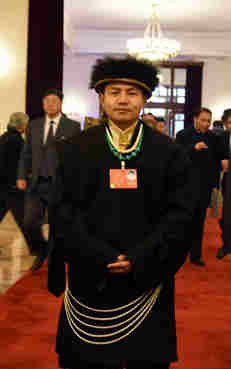


Tashi Gyaltsen, deputy of the National People's Congress (NPC) from Lhoba, an ethnic group in southeast Tibet Autonomous Region attends the opening ceremony. Photo: Cao Siqi/GT
A legislator from Lhoba, the second smallest of 56 ethnic groups in China living in the Tibet Autonomous Region, said the regional government is considering creating written scripts for the Lhoba language, a move the legislator hailed as another government effort to preserve ethnic culture.
Being the only deputy of the National People's Congress (NPC) from Lhoba, an ethnic group of around 3,600 people, Tashi Gyaltsen works hard to make sure his people's voice is heard by others.
Young people are living a more dynamic lifestyle and some traditional customs face the risk of extinction, Tashi said.
Tashi said that his work has gained the support of the regional government, which is considering creating a written script for his language.
Although the population of the Lhoba ethnic group is very small, the language divergence between different areas is large. Tashi said it is better to adopt the international phonetic system. However, he admitted that it is difficult to promote among the group.
Lhoba means "southerners" in Tibetan language and Lhoba people speak different languages but are considered the same Lhoba minority.
In 2008, Lhoba's ethnic clothing was listed in the second batch of the national intangible cultural heritage list.
Living in Shannan Prefecture, Tashi said preserving Lhoba culture is only a small part of the local and central governments' efforts in protecting Tibetan culture.
He said primary schools in Tibet still use Tibetan language textbooks, including mathematics. Tibetan course is taught from primary to high schools in this region, and universities in Tibet also offer a major in Tibetan language.
Meanwhile, the regional government also produced new radio gymnastics exercises featuring Tibetan folk dances so that the Tibetan people will not forget their traditional dances. In China, students across the country would line up every morning on the playground stretching, kicking and jumping to the music on the radio.
In recent years, some Western media have criticized China for increasingly restricting Tibetan culture. "The accusations are ridiculous," Tashi said.
The local and central governments have spared no effort to protect Tibetan culture. In the latest move, the central government plans to invest 300 million yuan ($44.9 million) in the next 10 years to protect and utilize ancient documents in the Potala Palace, a World Heritage site in Lhasa, Tibet.
A white paper released by the State Council Information Office in December 2018 says religious freedom for ethnic minority groups is also fully guaranteed.
Tibet has 1,778 venues for practicing Tibetan Buddhism, and normal religious activities and beliefs are protected based on the law, the white paper said.
 Fire brigade in Shanghai holds group wedding
Fire brigade in Shanghai holds group wedding Tourists enjoy ice sculptures in Datan Town, north China
Tourists enjoy ice sculptures in Datan Town, north China Sunset scenery of Dayan Pagoda in Xi'an
Sunset scenery of Dayan Pagoda in Xi'an Tourists have fun at scenic spot in Nanlong Town, NW China
Tourists have fun at scenic spot in Nanlong Town, NW China Harbin attracts tourists by making best use of ice in winter
Harbin attracts tourists by making best use of ice in winter In pics: FIS Alpine Ski Women's World Cup Slalom
In pics: FIS Alpine Ski Women's World Cup Slalom Black-necked cranes rest at reservoir in Lhunzhub County, Lhasa
Black-necked cranes rest at reservoir in Lhunzhub County, Lhasa China's FAST telescope will be available to foreign scientists in April
China's FAST telescope will be available to foreign scientists in April "She power" plays indispensable role in poverty alleviation
"She power" plays indispensable role in poverty alleviation Top 10 world news events of People's Daily in 2020
Top 10 world news events of People's Daily in 2020 Top 10 China news events of People's Daily in 2020
Top 10 China news events of People's Daily in 2020 Top 10 media buzzwords of 2020
Top 10 media buzzwords of 2020 Year-ender:10 major tourism stories of 2020
Year-ender:10 major tourism stories of 2020 No interference in Venezuelan issues
No interference in Venezuelan issues
 Biz prepares for trade spat
Biz prepares for trade spat
 Broadcasting Continent
Broadcasting Continent Australia wins Chinese CEOs as US loses
Australia wins Chinese CEOs as US loses